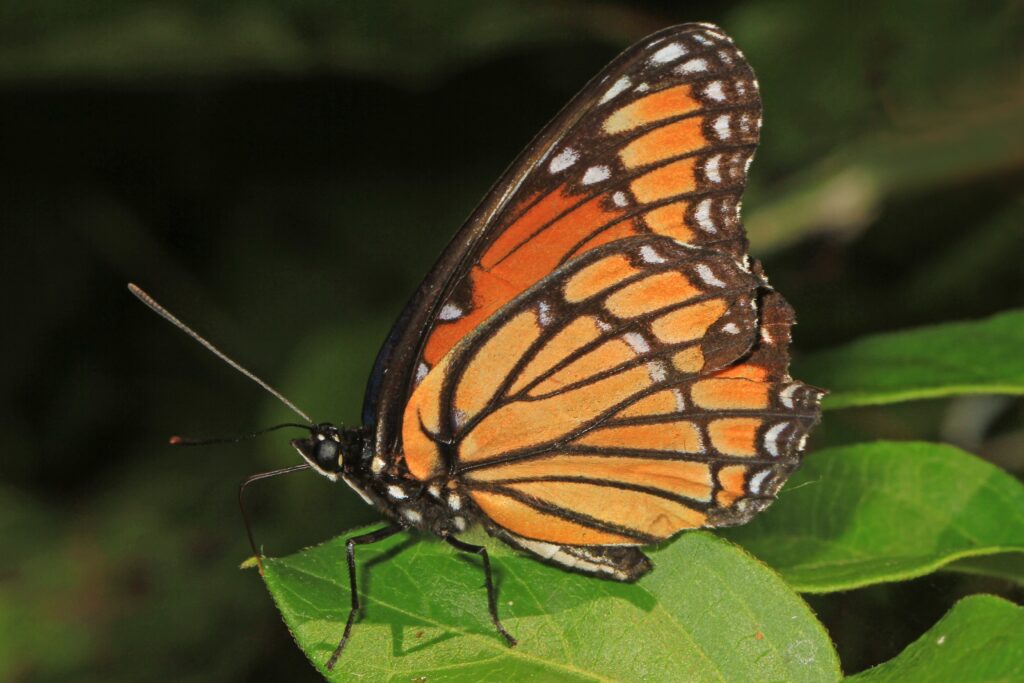Lookalike Butterflies: Monarchs and viceroys
Monarchs and viceroys are often confused due to their strikingly similar appearance. While once thought to be a one-sided mimicry, research shows both butterflies benefit from their resemblance. Discover the key differences and fascinating survival strategies of these two beautiful species.
You don’t have to disparage viceroy butterflies, the butterflies that look an awful lot like monarchs, except for being smaller and with an extra black stripe across the bottom of their wings. For years it was thought that the viceroy practiced Batesian mimicry, which is the fancy way of saying that it looked like the monarch to fool predators into thinking it would be unpalatable. The monarch is poisonous to many predators because as a caterpillar, it eats the poisonous milkweed, storing the bad stuff throughout its life; a predator eating a monarch will become quite ill, and will remember eating the monarch beforehand because of its bright colouring.

Batesian mimicry is like walking up to a bank teller with your hand shaped like a gun in your pocket; the teller gives you the money and you never had to bother getting a gun. For the viceroy to be a Batesian mimic, it would have to be harmless.
It turns out that the viceroy and monarch are practicing Müllerian mimicry, wherein both animals are unpalatable and benefit from looking like each other. Viceroy caterpillars feed on willows and poplars, sequestering the salicylic acid in their bodies, which is poisonous to many of their predators. In short, a bird who has eaten one viceroy before is unlikely to eat another viceroy or monarch; if it’s eaten a monarch, it probably won’t eat another monarch or a viceroy. It isn’t worth the upset stomach.
Strangely, it’s been known since at least 1991 that both butterflies benefit from looking alike, yet you still come across sources stating that the viceroy is opportunistic in its mimicry.

The viceroy has another striking attribute that protects it from predators. As a caterpillar, it looks for all the world like bird poop. And when it pupates, it looks like… hanging bird poop. As an egg, mamma lays it alone on the end of a willow or poplar tree, and it looks like a leaf gall.
The viceroy doesn’t journey south for the winter. Instead, it spends the winter as a third instar inside of a leaf on a poplar or willow tree. If it is getting late in the season, the caterpillar will spin a silk thread to encase a leaf of poplar or willow then curl into it; it will eat the leaf then just hang out for the winter, waiting for the tree to grow leaves again in spring, when it will emerge and continue its life cycle. Then it will pupate, become a butterfly, mate and the female will lay the eggs of the next generation. There are three or four generations per year.
Monarchs, on the other hand, migrate. The generation born late in the summer is lucky in that it will live eight months, rather than the usual six weeks. It is unlucky in that it will have to fly thousands of kilometers to Mexico to overwinter; then it starts the route back to Ontario. It develops sex parts on its way back, mates, and the female lays eggs on the first milkweeds she sees along the way, somewhere between Texas and Oklahoma. The butterflies that flew from Canada to Mexico don’t fly back; their children and grandchildren do.



